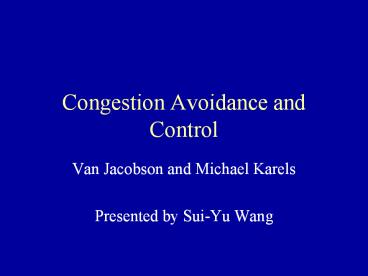Congestion Avoidance and Control PowerPoint PPT Presentation
Title: Congestion Avoidance and Control
1
Congestion Avoidance and Control
- Van Jacobson and Michael Karels
- Presented by Sui-Yu Wang
2
Introduction
- Congestion problem has become more severe as the
computer network grows - New algorithm forcing the packet conservation
can be used to achieve network stability - i) round-trip-time variance estimation
- ii) exponential retransmit timer backoff
- iii) slow-start
- iv) more aggressive receiver ack policy
- v) dynamic window sizing on congestion
3
Three ways for packet conservation to fail
- The connection doesnt get to equilibrium
- A sender injects a new packet before an old
packet has exited - The equilibrium cant be reached because of
resource limits along the path
4
Getting to equilibrium slow-start
- Self-clocking
- Gradually increase the data in transit
- Source of the picture fig1 in the paper
5
Getting to equilibrium slow-start
- Add a congestion window to the per-connection
state. - When starting or restarting after a loss, set
congestion window to on packet - On each ack for new data, increase congestion
window by one packet - When sending, send the minimum of the receivers
advertised window and congestion window
6
- Source of the picture fig2 in the paper
7
Conservation at equilibrium round-trip timing
- TCP
- Estimating mean round trip time
- Next packet sent
- Exponential backoff
8
- Source of the picture fig4 in the paper
9
- Source of the picture fig3 in the paper
10
Adapting to the path congestion avoidance
- Reasons that cause time out
- Packets damaged in transit
- Packets lost due to insufficient buffer
- Congestion avoidance
- The network must be able to signal the transport
endpoints that congestion is occurring - The endpoints must have a policy that decreases
utilization
11
Adapting to the path congestion avoidance
- Signal of a congested network drop of packets
- Measuring network load
- Smooth network
- Congested network
- Sender policy
12
Adapting to the path congestion avoidance
- On any timeout, set congestion window to half the
current window size - On each ack for new data, increase the congestion
window by 1/cwnd - When wending, send the minimum of the receivers
advertised window and cwnd
PowerShow.com is a leading presentation sharing website. It has millions of presentations already uploaded and available with 1,000s more being uploaded by its users every day. Whatever your area of interest, here you’ll be able to find and view presentations you’ll love and possibly download. And, best of all, it is completely free and easy to use.
You might even have a presentation you’d like to share with others. If so, just upload it to PowerShow.com. We’ll convert it to an HTML5 slideshow that includes all the media types you’ve already added: audio, video, music, pictures, animations and transition effects. Then you can share it with your target audience as well as PowerShow.com’s millions of monthly visitors. And, again, it’s all free.
About the Developers
PowerShow.com is brought to you by CrystalGraphics, the award-winning developer and market-leading publisher of rich-media enhancement products for presentations. Our product offerings include millions of PowerPoint templates, diagrams, animated 3D characters and more.

